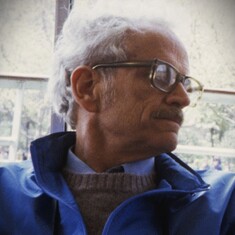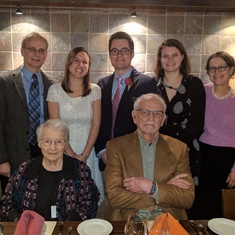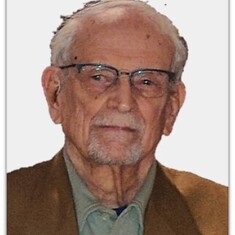January 10, 2023
January 10, 2023
Reflections shared by Faye Yoshihara at Mil’s Celebration of Life....
I first met Mil in Spring 2000 while facilitating a strategic planning session for the Trillium Artisan Project. Irene and Mil were participating at the request of their Executive Director, Nancy Yuill. As a Kellogg Fellow, I was trying to understand women’s economic empowerment after failing to turn prostitutes into hotel cleaning ladies in Thailand. Mil was one of two men in the room, and after he asked a question, I remember thinking…wow, this MAN is a feminist! In a debrief my co-facilitator Maria and I mulled a question that Irene had asked us – one that broke through the clutter of our own thinking. We vowed to get Irene and Mil’s contact information.
And so we did. I became a regular at the Development Salon. Kevin and I ended up as Mil and Irene’s Pettygrove St neighbors while we remodeled a house nearby. During that year we got to know Irene and Mil better. Kevin shared an interest in hand tools with Mil and appreciated his precise manner of speech and dress. I realized that Mil was in post WWII Japan about the same time as my Nisei uncle, both on parallel tracks serving in military intelligence. After we moved into our remodeled house, we stayed connected by going out to dinner. By this point, Mil did not care to drive at night, so Kevin drove and we’d ask Mil and Irene to choose the restaurant. Both choose the Bombay Cricket Club. Mil’s choices were the Blue Hour, another hot new restaurant he had heard about, or Japanese. Mil’s language capabilities far outstripped mine. He would occasionally try to speak to me in Japanese. I could understand more than I could speak but was unable to carry on a conversation. When we got to a Japanese restaurant, Mil went all in, ordering Kirin Ichiban or Asahi Dorai, bantering with the waitstaff – with luck, a young, Japanese national, waitress - about the nigiri sushi, maki sushi, ebi, hamachi or whatever was fresh. These waitresses surely left wondering why the very polite White man ordered in the formal Japanese of her grandparents, while I ordered in English. Mil and my parents were probably speaking a similar version of Japanese, as I was reminded that I was using old-fashioned terms on work trips to Japan in 1990’s. I was introduced, as Mil would have been, as a gaijin (foreigner) or America-jin.
Mil and our lives also both pass through Corvallis, where Kevin and I currently live and Mil served in the military. When Janet drove Mil and Irene to visit us several years ago it sparked his memories of Camp Adair. He had little nice to say about his days living in what he remembered as a swampy, mosquito infested, war-time encampment. However, his time at Oregon State College and patrolling the Oregon Coast were remembered more fondly. Thank you, Janet for enabling the visit.
The last time Kevin and I saw Mil was on the happy occasion of his 100th birthday celebration and Asian Encounters book signing. It was a delight to see Mil walk in with such energy and spirit, dressed in his beautiful Indonesian batik shirt, the fabric of which he would always remind me he saw being hand printed. I had read an earlier draft of Mil’s memoir, which had left me at the North African coast, wondering how they got back to London. So, I was very happy to learn the rest of the story.
Kevin and I extend our deepest condolences to Irene and their family. And, as we think Mil would approve, we raise a glass in celebration of a life very well lived.
I first met Mil in Spring 2000 while facilitating a strategic planning session for the Trillium Artisan Project. Irene and Mil were participating at the request of their Executive Director, Nancy Yuill. As a Kellogg Fellow, I was trying to understand women’s economic empowerment after failing to turn prostitutes into hotel cleaning ladies in Thailand. Mil was one of two men in the room, and after he asked a question, I remember thinking…wow, this MAN is a feminist! In a debrief my co-facilitator Maria and I mulled a question that Irene had asked us – one that broke through the clutter of our own thinking. We vowed to get Irene and Mil’s contact information.
And so we did. I became a regular at the Development Salon. Kevin and I ended up as Mil and Irene’s Pettygrove St neighbors while we remodeled a house nearby. During that year we got to know Irene and Mil better. Kevin shared an interest in hand tools with Mil and appreciated his precise manner of speech and dress. I realized that Mil was in post WWII Japan about the same time as my Nisei uncle, both on parallel tracks serving in military intelligence. After we moved into our remodeled house, we stayed connected by going out to dinner. By this point, Mil did not care to drive at night, so Kevin drove and we’d ask Mil and Irene to choose the restaurant. Both choose the Bombay Cricket Club. Mil’s choices were the Blue Hour, another hot new restaurant he had heard about, or Japanese. Mil’s language capabilities far outstripped mine. He would occasionally try to speak to me in Japanese. I could understand more than I could speak but was unable to carry on a conversation. When we got to a Japanese restaurant, Mil went all in, ordering Kirin Ichiban or Asahi Dorai, bantering with the waitstaff – with luck, a young, Japanese national, waitress - about the nigiri sushi, maki sushi, ebi, hamachi or whatever was fresh. These waitresses surely left wondering why the very polite White man ordered in the formal Japanese of her grandparents, while I ordered in English. Mil and my parents were probably speaking a similar version of Japanese, as I was reminded that I was using old-fashioned terms on work trips to Japan in 1990’s. I was introduced, as Mil would have been, as a gaijin (foreigner) or America-jin.
Mil and our lives also both pass through Corvallis, where Kevin and I currently live and Mil served in the military. When Janet drove Mil and Irene to visit us several years ago it sparked his memories of Camp Adair. He had little nice to say about his days living in what he remembered as a swampy, mosquito infested, war-time encampment. However, his time at Oregon State College and patrolling the Oregon Coast were remembered more fondly. Thank you, Janet for enabling the visit.
The last time Kevin and I saw Mil was on the happy occasion of his 100th birthday celebration and Asian Encounters book signing. It was a delight to see Mil walk in with such energy and spirit, dressed in his beautiful Indonesian batik shirt, the fabric of which he would always remind me he saw being hand printed. I had read an earlier draft of Mil’s memoir, which had left me at the North African coast, wondering how they got back to London. So, I was very happy to learn the rest of the story.
Kevin and I extend our deepest condolences to Irene and their family. And, as we think Mil would approve, we raise a glass in celebration of a life very well lived.




